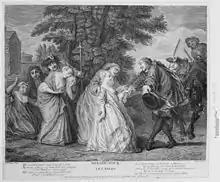Casquette girl
A casquette girl (French: fille à la cassette) but also known historically as a casket girl or a Pelican girl,[1] was a woman brought from France to the French colonies of Louisiana to marry.[2][3] The name derives from the small chests, known as casquettes, in which they carried their clothes.[3][4]

History
The French policy of sending young women orphans known as King's Daughters (French: filles du roi) to their colonies for marriage custom goes back to the 17th-century. Young women were sent to Canada, Louisiana and the French West Indies.
Normally women were supplied to the colonists by raking the streets of Paris for undesirables, or by emptying the houses of correction. France also sent women convicted along with their debtor husbands, and in 1719, deported 209 women felons "who were of a character to be sent to the French settlement in Louisiana.".[5] The women sent to the West Indies were often from poor houses in France, but reputed to be former prostitutes from La Salpêtrière. In 1713 and again in 1743, the authorities in Saint-Domingue complained that Paris sent the settlers unsuitable former prostitutes as wives, and the practice was discontinued in the mid 18th-century.[6]
The casquette girls, however, were conspicuous by reason of their virtue. They were recruited from church charitable institutions (usually orphanages and convents) and although poor, were guaranteed to be virgins.[7] It later became a matter of pride in Louisiana to show descent from them.[3] The first casquette girls reached Mobile, Alabama in 1704, Biloxi, Mississippi in 1719, and New Orleans in 1728.[3][8]
Historian Joan Martin maintains that there is little documentation that casket girls, considered among the ancestors of white French Creoles, were sent to Louisiana. Dr. Marcia Zug argues that there was, in fact, no evidence to support the fact that these women existed as such.[9] The Ursuline order of nuns supposedly chaperoned the casket girls until they married, but the order has denied this. Martin suggests this was a myth, and that interracial relationships occurred from the beginning of the encounter among Europeans, Native Americans and Africans. She also writes that some Creole families who today identify as white had ancestors during the colonial period who were African or multiracial, and whose descendants married white over generations.[10]
Cultural impact
Fiction
- They inspired Victor Herbert to write Naughty Marietta which was turned into a musical in 1935.
- In the 1947 movie, The Foxes of Harrow, Maureen Sullivan is costumed as a Casquette Girl during a ball.
- The French, a novel by W. Maureen Miller, is about Madeline, a young French girl who is sponsored by a convent and sent to Louisiana to become the bride of a pioneering colonist.
Music
- Musicians Phaedra Greene, Elsa Greene, and Ryan Graveface formed the Savannah, Georgia-based band Casket Girls.[11][12]
- In 2018, Gregory Hancock Dance Theatre performed the ballet "The Casket Girls" in Carmel, Indiana. With music composed by Cory Gabel and choreography by Gregory Hancock. It was inspired by the original casquette girls, telling the origin of vampires in New Orleans.[13][14]
References
- Kazek, Kelly. "When French orphans called Casket Girls came to Alabama as wives for colonists". Al.com. Retrieved 29 November 2016.
- See Dureau, Lorena. The Last Casquette Girl, 1981, Pinnacle Books ISBN 0523412665
- Lee Smith (January 21, 2011). "Women in Colonial Louisiana". Encyclopedia of Louisiana. Louisiana Endowment foir the Humanities. Archived from the original on June 12, 2011. Retrieved May 21, 2011.
- Higginbotham, Jay. Old Mobile: Fort Louis de la Louisiane, 1702-1711, pp.106–07. Museum of the City of Mobile, 1977. ISBN 0-914334-03-4.
- Katy F. Morlas, "La Madame et la Mademoiselle," graduate thesis in history, Louisiana State University and Agricultural and Mechanical College, 2003
- Trevor Burnard, John Garrigus: The Plantation Machine: Atlantic Capitalism in French Saint-Domingue
- Clark, Emily. Masterless Mistresses: The New Orleans Ursulines and the Development of a New World Society, 1727–1834, pp. 12–23. Chapel Hill: The University of North Carolina Press, 2007. ISBN 978-0-8078-5822-6.
- Thomason, Michael. Mobile : the new history of Alabama's first city, pages 20-21. Tuscaloosa : University of Alabama Press, 2001. ISBN 0-8173-1065-7
- Zug, Marcia A. (2016). Buying a Bride. NYU Press. ISBN 9780814771815. JSTOR j.ctt1804024.
- Joan M. Martin, Placage and the Louisiana Gens de Couleur Libre, in Creole, edited by Sybil Kein, Louisiana State University Press, Baton Rouge, 2000.
- Waterman, Cole. "The Casket Girls: The Night Machines". PopMatters has. Retrieved 11 December 2018.
- Boilen, Bob. "First Watch: Casket Girls, 'Tears Of A Clown'". NPR Music. Retrieved 11 December 2018.
- ""The Casket Girls" at Gregory Hancock". Arts Channel Indy. Retrieved 11 December 2018.
- Ambrogi, Mark. "Hancock Dance Theatre presents 'The Casket Girls'". Current Publishing. Retrieved 11 December 2018.